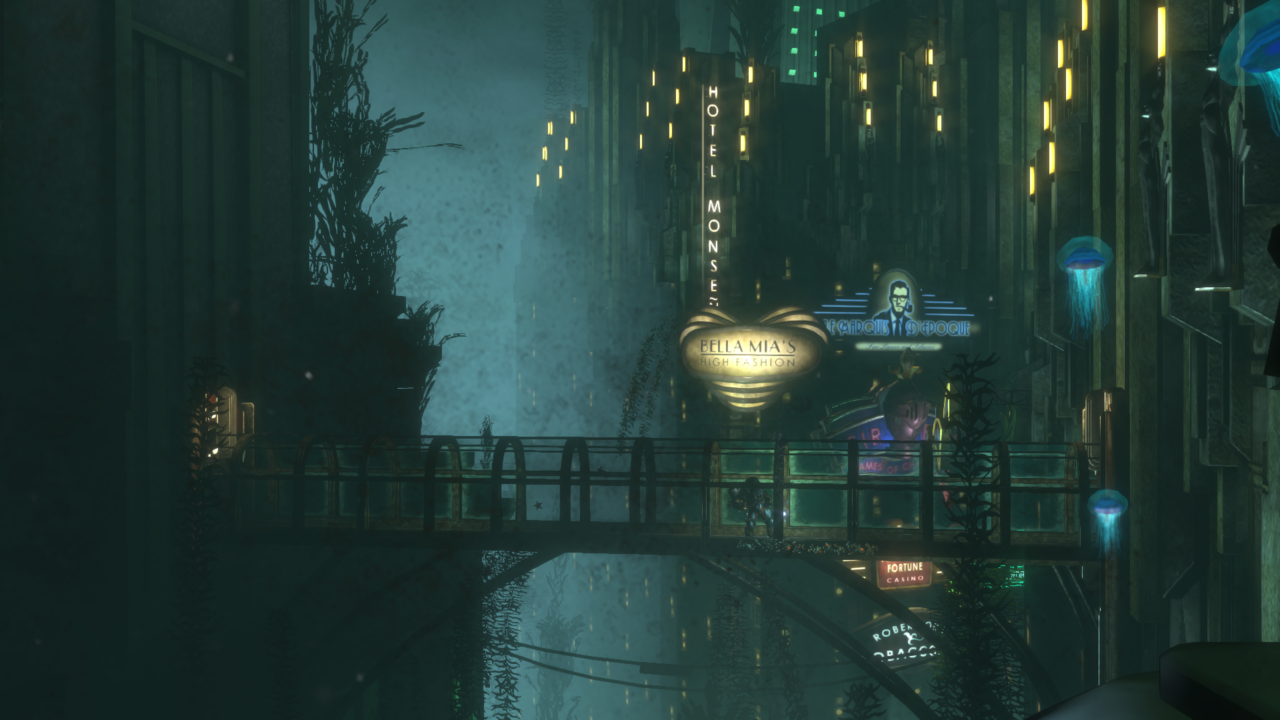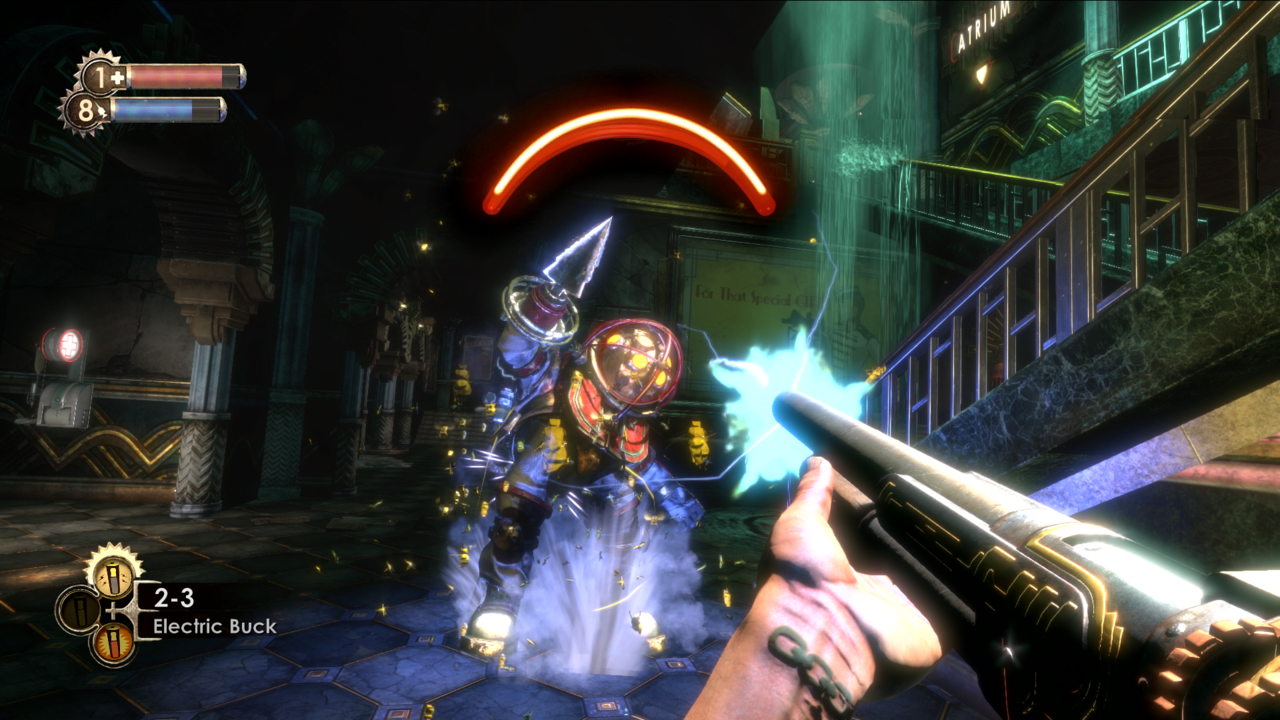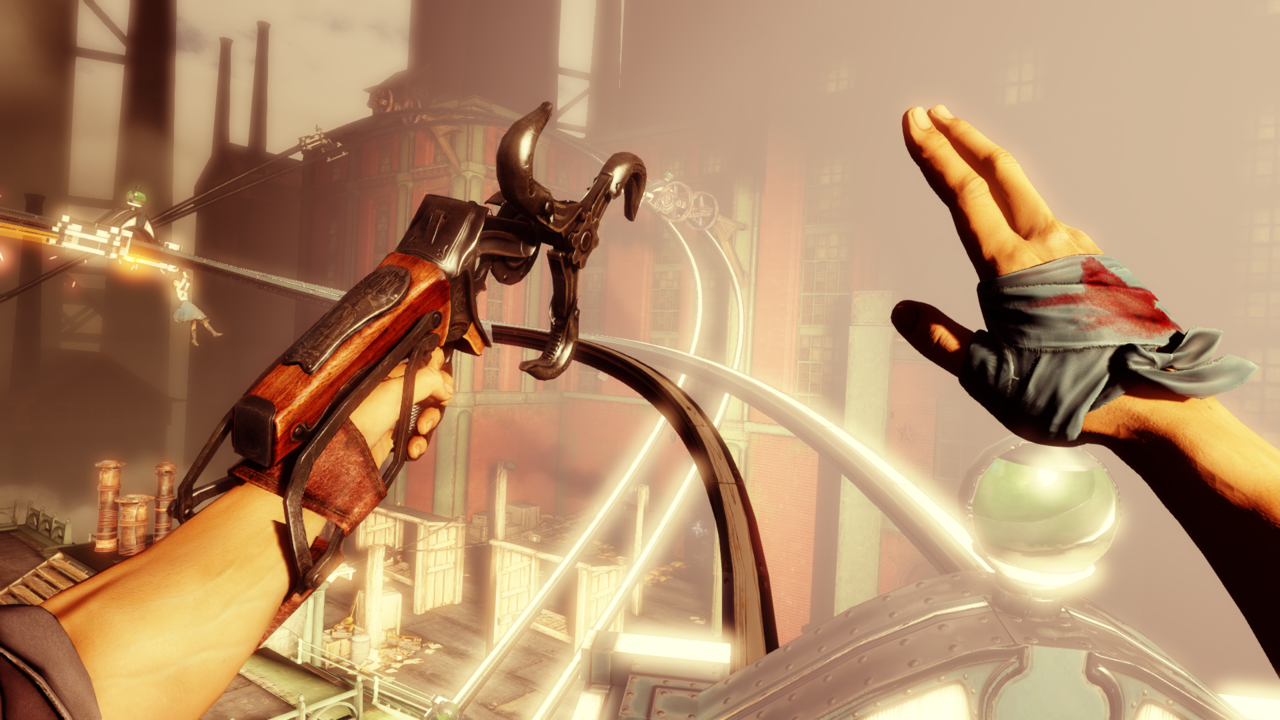It's been nine years since we first went to Rapture. A lot has changed in the time since BioShock first launched. Game design has shifted considerably, hardware has gotten better, graphics look more photorealistic than ever before. But while our world is constantly in flux, the world of Rapture is just as atmospheric, haunting, and oppressive as you remember it. The tyrant, Andrew Ryan, is just as Ayn Rand-ian. Big Daddies still hulk and lumber with their creepy girlish companions, Little Sisters, at their feet.
I went hands-on with the remastered version on PS4 coming in BioShock: The Collection, and it felt like I had been transported back to the first time I played the game. 2K has gone back and spent a lot of time with the original, sharpening it up and generally making it feel more modern. It's not just a fresh coat of paint, though: in addition to increasing its resolution, the publisher has added new details to the environments. For example, when you enter Rapture at the beginning of the game, you're surrounded by ocean life. Jellyfish swim by you; starfish hang from the city's structures; schools of fish move through the water.

Rapture itself looks even more menacing and mystical. The original game had environments that didn't just look good, but also imparted little pieces of narrative that fleshed out the world and gave you more grounding in the story. Irrational Games built a masterpiece of environmental storytelling back in 2007, and the remaster emphasizes this. The levels you move through are gorgeously rendered, and the small hints of the cataclysmic events that had befallen Rapture have received care and attention to make them look as good as possible.
It's beautiful and atmospheric, but even more than that, it just doesn't look like an "old" game anymore. Its graphics won't blow you away, but it's hard to see rough edges and signs of age. The full effect of the remaster only really hits if you go back to the original and see how much has been reworked and overhauled. But that's okay: the remaster doesn't need to make a nine-year-old game look incredible according to 2016 standards. But it does need to do enough that you aren't distracted from the beautiful art and entrancing world of Rapture. And at that, it succeeds.
Helping matters, the remaster now runs at a solid 60 frames per second on consoles. Since BioShock is a first-person shooter, this makes a significant difference in gameplay. As a result, in addition to looking better, the remastered BioShock also plays better. 60 FPS makes shooting and moving smoother, and its fast-paced combat benefits greatly from this change. It eliminates some of the relics of its age that makes returning to the original game less fun than you'd wish.

It's worth noting, though, that while I love the story and world of BioShock, Irrational made certain design decisions that caused me to never finish the game, and these parts of the game still remain. The oppressive atmosphere of BioShock is its strength, but I still don't think that backtracking through rooms full of infinitely spawning splicers complements that tone. Fetch-quest missions and the weird level that tasks you with taking photos of certain enemies, too, feel anachronistic, design choices of an older generation of shooters.
For people like me, who weren't terribly impressed with BioShock's gameplay, the far more action-y BioShock Infinite is also included in BioShock: The Collection. If you owned the game on PC, you won't notice much difference: this version of Infinite is essentially the PC version. But if you played it on a console like me, this remaster shows that Infinite is, at least graphically, the crown jewel of the BioShock series.
Even though it's been more than three years since BioShock Infinite launched, the game looks almost like it could be released tomorrow. Columbia is gorgeous, full of vibrant colors and minute detail, and the constantly moving cloud city looks just as interesting as ever. And although character design shows a bit of age--eyes and faces are generally expressionless--the game as a whole looks incredible.
Infinite plays great, too. It clearly shows the lessons that Irrational learned about shooter design over the six years between the first BioShock and Infinite. For example, guns are snappier and more satisfying to shoot, and the Skyhook makes for both a brutally entertaining melee weapon and a tool for opening Columbia to rapid exploration and movement. Infinite also now runs at 60 FPS on consoles, which makes its rhythmic, rapid combat feel even better. BioShock 1 received the most work in the collection, but Infinite got enough of a remaster that it's well worth returning to it. I loved playing through the first few hours of Infinite again, exploring the world and discovering secrets that I had never known existed.

If an overhauled BioShock and a better-looking Infinite aren't enough, BioShock: The Collection also comes with a remastered BioShock 2. I didn't play much of BioShock 2, but I played enough to verify that it looks considerably better than its original console versions. It, too, runs at 60 FPS, and its levels are more detailed and look sharper. However, it has not received the same amount of attention as BioShock 1, and its cutscenes and some of the smaller environmental features show the game's age. But if you're like me and never actually played BioShock 2, this is the best way to try it now--especially since it comes in a pack with BioShock 1 and Infinite.
If you're not interested in the core BioShock 2, though, its addition in the pack ensures that you'll also get access to the well-received DLC, Minerva's Den. Minerva's Den is arguably the most notable DLC in the series, lauded for its great narrative and tone and developed by people who later went on to make Gone Home. In fact, The Collection comes with every piece of extra content released for every BioShock game (besides BioShock 2's multiplayer, which isn't getting ported).
As it brings all of these pieces together, BioShock: The Collection is shaping up to be a fantastic monument to the series. In my time with the three games, I realized that this is so much more than simply a remaster of a beloved title. It's a preservation effort--a way to experience a series that meant so much to so many people and that influenced future games in so many ways. The Collection lets you replay (or play for the first time) games that are largely considered masterpieces of storytelling and worldbuilding. And it doesn't stop there: every piece of single-player BioShock content is included in this, and BioShock 1 even features director's commentary with game director Ken Levine and lead artist Shawn Robertson.
Remasters get a lot of flak these days, and not without reason. But BioShock: The Collection includes enough that it's well worth the price to return to prettier, but just as haunting, versions of Rapture and Columbia.








